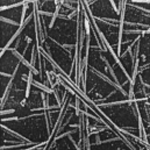Every substance is made from atoms, and every atom contains electrons. Simply put, magnetic fields have a short-term impact on the electrons contained inside the atoms of a substance.
When tap water passes through a strong magnetic field, about 75% of the calcium minerals that form hard-water are changed such that they do not bond together as well. The result is that the hard-water is softened.
 Without being subjected to a powerful magnetic Field, the calcium in tap water forms calcite which are tiny and jagged, and tend to latch on to surfaces with significant holding strength. The hard-water scale is tough to remove. (10 μm electron microscope images) |  After exposure to the MagneMagic magnetic field, the calcium forms aragonite which are clumped together in larger groups, and have less holding strength once latched on to surfaces. The hard-water scale wipes away. ( 10 μm electron microscope images) |
J. M. D. Coey and Stephen Cass authored a paper entitled “Magnetic Water Treatment” for the Journal of Magnetism and Magnetic Materials #209 in the year 2000. J.M.D. Coey is a physicist and academician considered by may to be one of the most important minds in the modern scientific understanding of magnetism.
In their study of the science of magnetic water treatment, they passed water through a magnetic field of 1,000 Gauss and into a glass beaker. The water in the glass beaker was then evaporated, and the scale left behind was studied under an electron microscope and X-ray diffraction. The results found that there are two types of varrying calcium deposits: calcite and aragonite. While both calcite and aragonite are made of calcium, their structure is very different.
 Calcite structure is very small and is therefore more prone to clinging to surfaces. (50 μm electron microscope images) |  Aragonite forms in a longer structure which makes it more resistant to clinging to surfaces. (50 μm electron microscope images) |
Their research also confirmed that the maximum effect of the magnetism lasts for approxiamtely 40 hours, with the effect tapering off for the following 160 hours.
Based on this research, MagneMagic set out to prove an additional hypothesis, this time directed toward plumbing appliances in the home. We thought that magnetic water scale softener treatment would be better placed near the water outlet on plumbing appliances because the immediate effect of the magnetism changing the calcium into aragonite has a limited lifespan. Therefore, if the aragonite was immediately deposited onto a surface, then more of the scale should resist sticking to the surface and run off. Additionally, the scale that remains on the surface should dry with much more aragonite structure than calcite structure, so it should be easier to clean the surface and remove the scale deposits.
This is contrary to many magentic water treatment products that claim to treat the whole house, or a major plumbing appliance such as a water heater. This is because water can remain stagnant in water pipes and large appliances for many hours, reducing the effects of the magnetism over time, and allowing the aragonite to convert back to calcite.
So we set out to prove our hypothesis in a series of tests lasting over a period of two weeks.
 Without MagneMagic Multiple common surfaces subjected to calcified tap water spray for 15 minutes every hour, for a period of 14 days. No cleaning applied to surfaces. |  With MagneMagic Multiple common surfaces subjected to magnetic water softener treated calcified tap water spray for 15 minutes every hour, for a period of 14 days. No cleaning applied to surfaces. |
The results are clear; the surfaces subjected to the MagneMagic magnetic water softening technology exhibit far less scale buildup without subjecting any of the surfaces to cleaning. Additionally, when cleaning the surfaces, the MagneMagic magnetic water softening technology treated surfaces cleaned up more easily than the surfaces without the magnentic water treatment.

